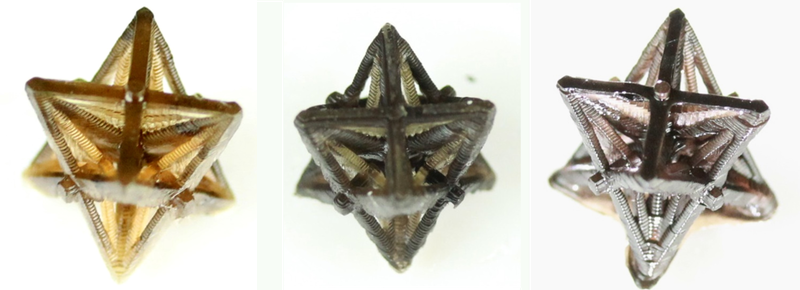3D Structure Shrinks When Heated
Most solid materials expand when they get hot, but a few shrink. A team of engineers has now used a combination of two heat-expanding materials to fabricate a heat-contracting composite. The star-shaped structures contract in all three dimensions when heated, whereas previous structures of this type only worked in two dimensions. In addition, the researchers could adjust the degree of thermal contraction by changing the amount of copper added to one of the materials. Using shrinkable composites in conjunction with conventional materials could lead to structures that maintain their shape over a wide temperature range, potentially a good thing for window frames, water pipes, and space technologies.
Whether it’s hardware on the Space Station or pipes under the streets, many materials experience temperature changes that cause stress through repeated cycles of expansion and contraction. To make a structure that doesn’t change size with temperature, one could combine a material that expands when heated with one that shrinks. These shrinking materials have a property called negative thermal expansion (NTE).
Playing with chemistry to get the specific atomic interactions needed for NTE is a finicky, time-consuming process. Instead, researchers have turned to replicating the molecular bending and twisting responsible for NTE in some solids [1] by patterning materials on the macroscale. This approach speeds up fabrication, and the structures are inherently more tunable—tweaking a pattern is painless in comparison to changing a material’s atomic structure.
Theorists have predicted that NTE could be achieved in void-containing structures, where two different materials are intertwined in a mesh-like configuration [2, 3]. If the two materials expand at different rates when heated, the walls of the structure can be induced to fold inwards, filling the voids and ultimately taking up less space. However, so far, researchers have been limited in the complexity of the structures they could produce and in the materials that could be used. To make these intricate designs, two different materials need to be simultaneously sculpted into interlocking geometries—a difficult job for traditional fabrication methods.
Nicholas Fang of the Massachusetts Institute of Technology and his colleagues realized that a new 3D printing technique could handle this challenge. Taking inspiration from the octahedron-like atomic structure of NTE solids, the researchers designed a series of star-shaped structures made of pyramids that their calculations indicated would contract when heated. To force the star to bend in on itself, its internal struts needed to be made from the material with greater thermal expansion. The team expected that as these struts expanded, the more rigid external frame would force the struts to fold into the star’s empty middle (see videos).
They fabricated their design using a recently developed 3D printing method that prints using two different materials [4]. They printed the struts and the frame from the same polymer but mixed copper nanoparticles into the frame material. The nanoparticles decreased the frame's thermal expansion, creating enough of a mismatch with the struts to trigger the expected folding.
Fang and his colleagues heated a series of similar structures and found that shrinking began at around 370 K and continued through 530 K, the maximum temperature for their experiments. The total volume reduction was up to 1%, but it was highly dependent on the concentration of copper in the frame material. With 10% copper by volume, the size change was 3 times greater than for 2% copper. This ability to precisely tune the NTE effect potentially allows materials to be tailored to meet the specific needs of each situation.
The team has shown that it can create NTE materials “through design and by carefully selecting material constituents,” says Julia Greer of the California Institute of Technology in Pasadena, where her research focus is creating advanced 3D materials. She says the work “creates a pathway to zero-expansion materials, which would really help prevent many of the mechanical failures that occur today, caused by extreme thermomechanical environments.”
This research is published in Physical Review Letters.
–Katherine Wright
Katherine Wright is the Deputy Editor of Physics Magazine.
References
- J. N. Hancock, C. Turpen, Z. Schlesinger, G. R. Kowach, and A. P. Ramirez, “Unusual Low-Energy Phonon Dynamics in the Negative Thermal Expansion Compound ZrW2O8,” Phys. Rev. Lett. 93, 225501 (2004).
- R. Lakes, “Cellular Solids with Tunable Positive or Negative Thermal Expansion of Unbounded Magnitude,” Appl. Phys. Lett. 90, 221905 (2007).
- O. Sigmund and S. Torquato, “Composites with Extremal Thermal Expansion Coefficients,” Appl. Phys. Lett. 69, 3203 (1996).
- J. W. Choi, H. C. Kim, and R. Wicker, “Multi-material Stereolithography,” J. Mater. Process. Technol. 211, 318 (2011).
More Information
Animations of the molecular motions leading to NTE in zirconium tungstate (right click on videos and choose “loop”): Focus: Bake, Shake, and Shrink
Another NTE material: Focus: New Vibration in Material That Shrinks When Heated





